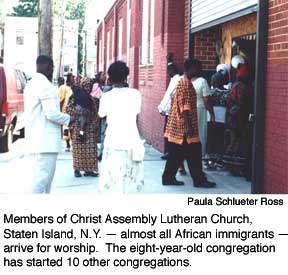By Paula Schlueter Ross
The Lutheran Church–Missouri Synod welcomed 94 new congregations in 2003 — 10 more than the previous year and the most in at least 15 years, according to Dr. Robert Scudieri, associate executive director, National Mission Team, for LCMS World Mission. In fact, he said, the average is “about 60” for each year in the past decade.
Almost two-thirds of the new congregations — 62 — are among non-white ethnic groups, according to Scudieri. Although “Anglos,” with 32 new congregations, make up the largest singl
Scudieri emphasized that the new congregations are “Word and sacrament missions,” not ministries such as Bible studies or English classes, although the latter are often “a first step” to beginning a new congregation, he said.
The Florida-Georgia District reported the highest number of new starts of the Synod’s 35 districts. Nine of its 14 new congregations are non-white, with five Hispanic and four African immigrant. Moreover, almost all of those new congregations were started by existing congregations, rather than district-office administrators, which is significant, according to Scudieri.
“More and more LCMS churches are taking this kind of initiative and starting new missions,” he said. “We’re going back to the way we used to do it.”
Prior to World War II, congregations started other congregations, Scudieri said. Later on, LCMS districts took charge of church planting and continued to make the decisions for decades.
Now, with tightening budgets and the realization that congregations are more knowledgeable about the mission opportunities in their own backyards, districts are encouraging their congregations to reach out on their own, he said.
“Missions is truly job one” in the Florida-Georgia District, according to Rev. Doug Kallesen, executive director of outreach for the district. With so many people moving into the area, Kallesen says, there are “a lot of opportunities” for outreach.
The district has its own outreach committee, which looks for opportunities to plant churches, then works with local congregations to make it happen. In fact, seven of the nine congregations started this year were started by existing congregations, as “mother-daughter” plants, he said.
Florida-Georgia also commits a majority of its budget — about 60 percent — to missions, and makes more than $1 million a year available for “mission grants” to its congregations.
The Florida-Georgia District also is intentionally “multicultural” in outreach, Kallesen says: “We want to reflect the community in which we live.”
Multicultural and non-white ethnic congregations are a blessing to the Missouri Synod, says Scudieri, because immigrant churches generally “have taken the initiative more so than Anglos in starting new missions.”
As an example, Scudieri points to Christ Assembly Lutheran Church, Staten Island, N.Y., a congregation of African immigrants that has started 10 congregations in eight years.
Christ Assembly Pastor Philip Saywrayne says he and other African immigrants have adopted a goal of reaching out to 500,000 people in the Northeast United States as part of the Ablaze! emphasis.
“Our ministry is responding to the Great Commission of our Lord Jesus Christ,” Saywrayne explained. And, he added, members are excited about Ablaze! “That’s why we are going about developing congregations and reaching out to people,” he said.
Many Africans “have come through extreme suffering because of their faith, and they bring a strong commitment and a bold witness to their faith,” Scudieri said. “We are really learning from immigrant churches how to start new missions.”
Resources are available for those who want to learn more about church planting, and Scudieri suggests the Center for U.S. Missions in Irvine, Calif., which offers training for church planters and congregational leaders, including the Daughter Church Planting Seminar and the Mission Planters Institute. For information,
visit the center’s Web site at www.centerforusmissions.org or call (949) 854-8002, Ext. 1781.
The Synod’s Pentecost 2000 Web site at www.pentecost2000.com carries descriptions of more than 1,000 cross-cultural ministries, and includes telephone numbers and e-mail addresses of contact persons who can supply more information.
Starting a new congregation doesn’t have to be complicated, says Scudieri. Many start simply, he said, “with a demonstration of Christian love to a new people.”
Posted June 25, 2004
